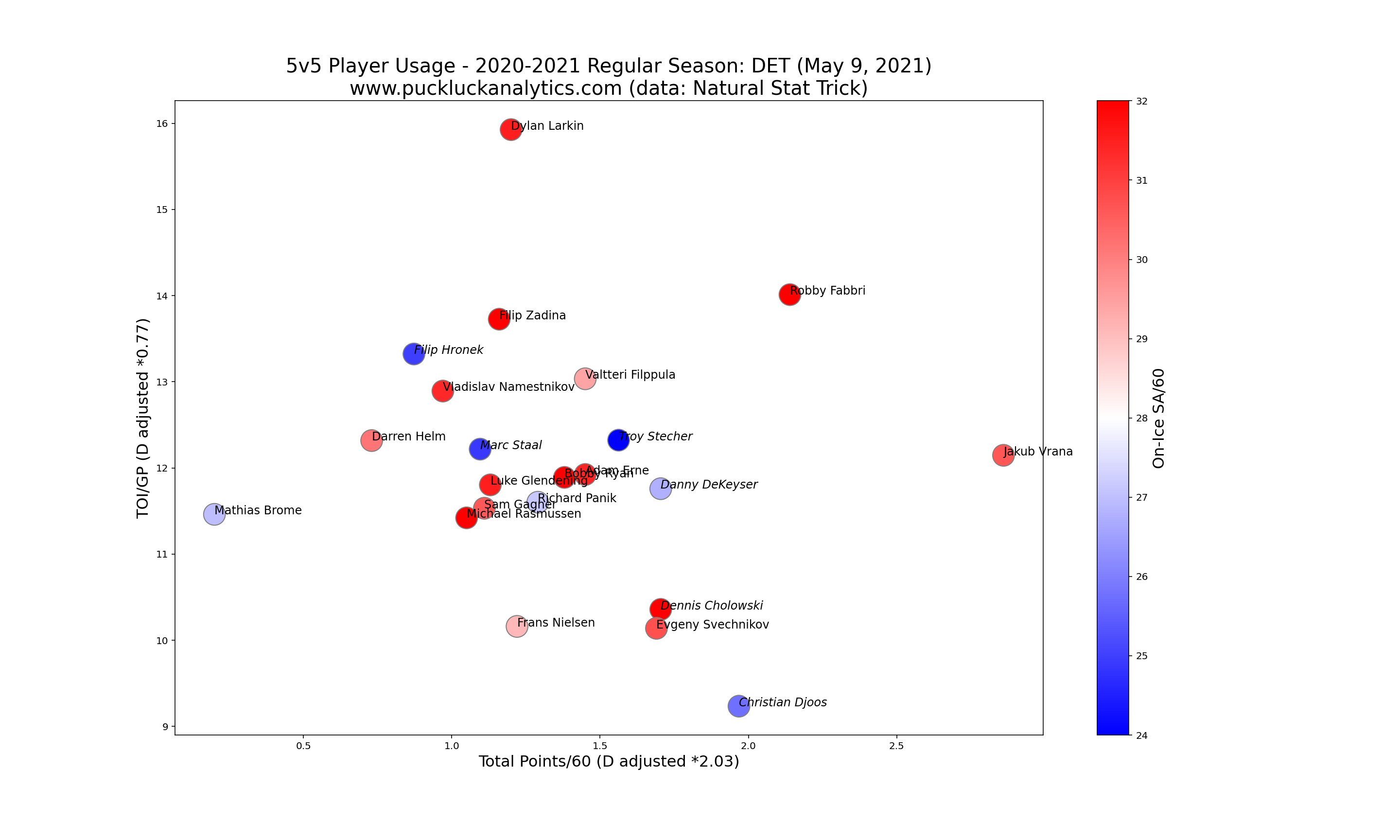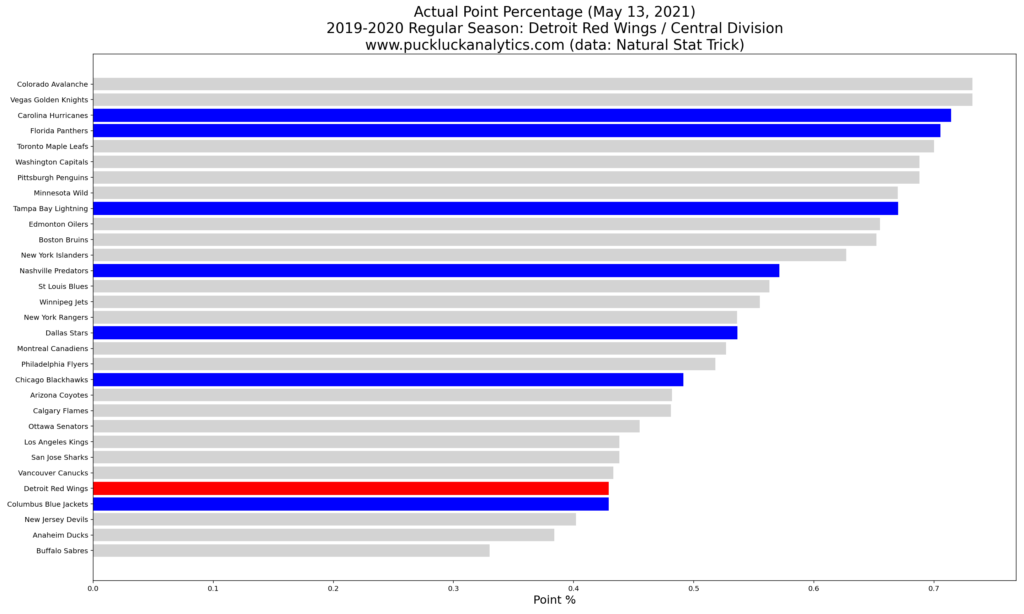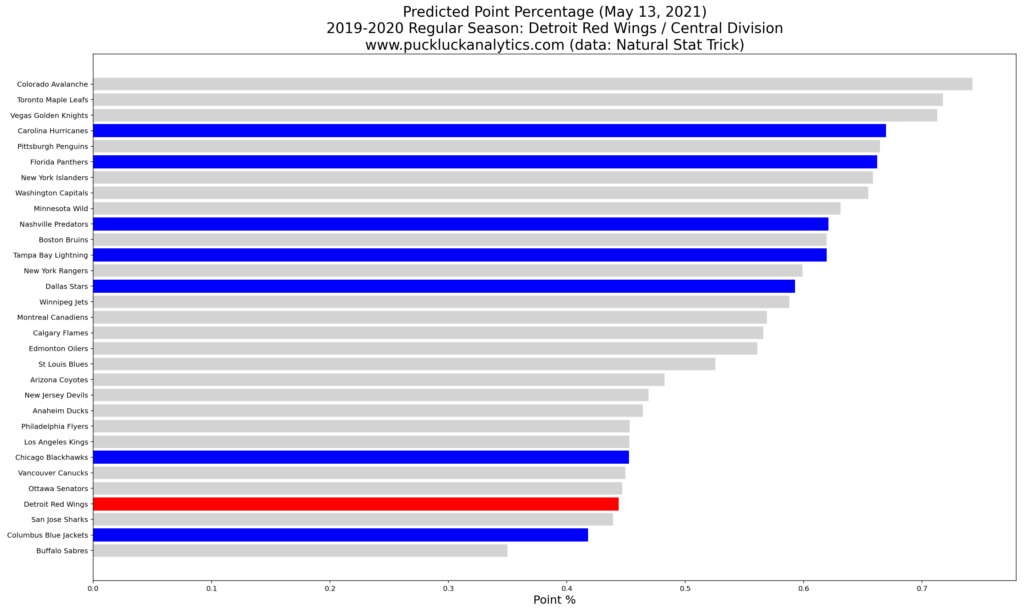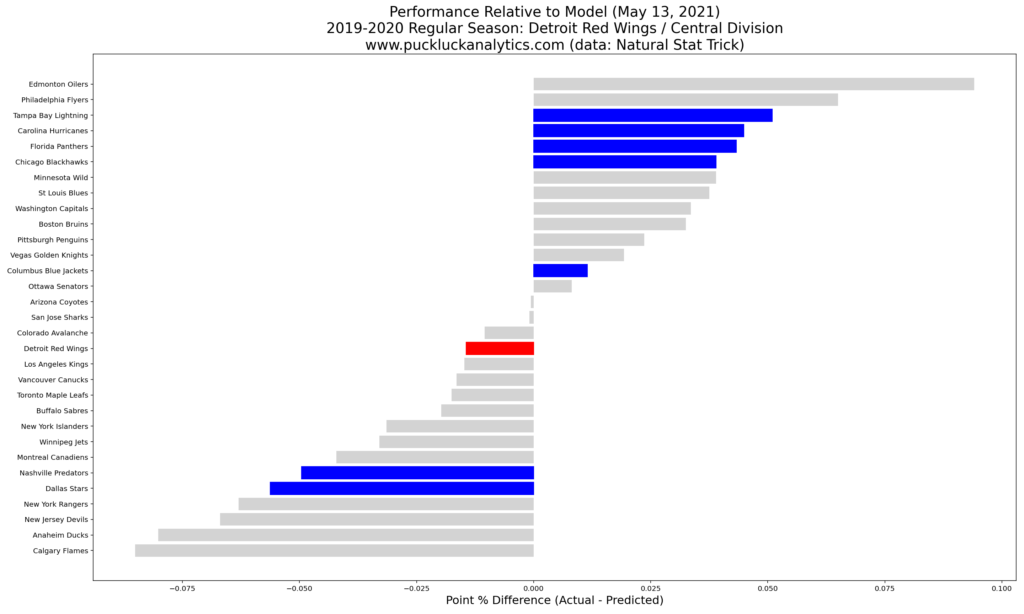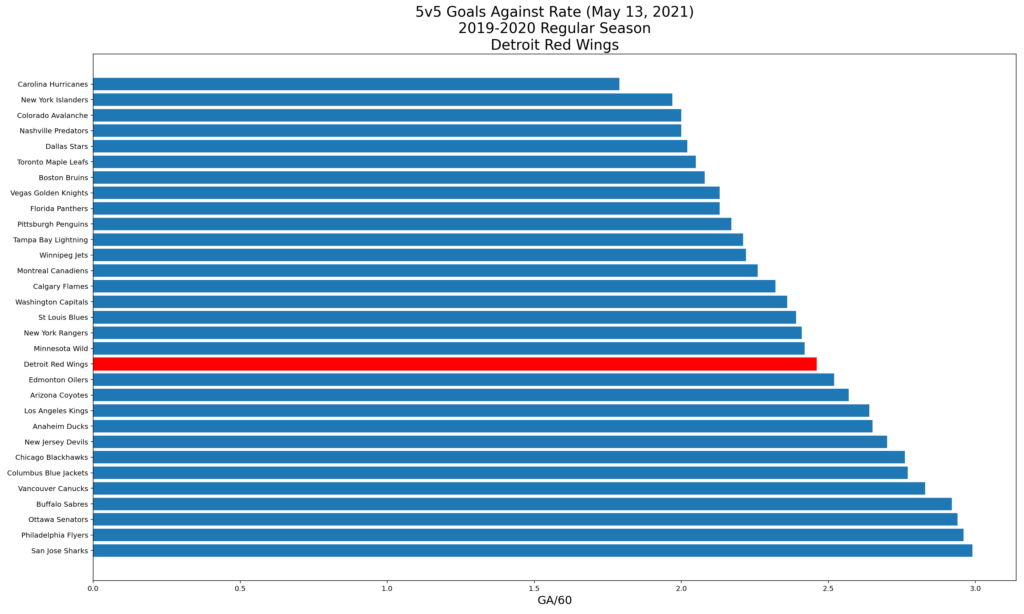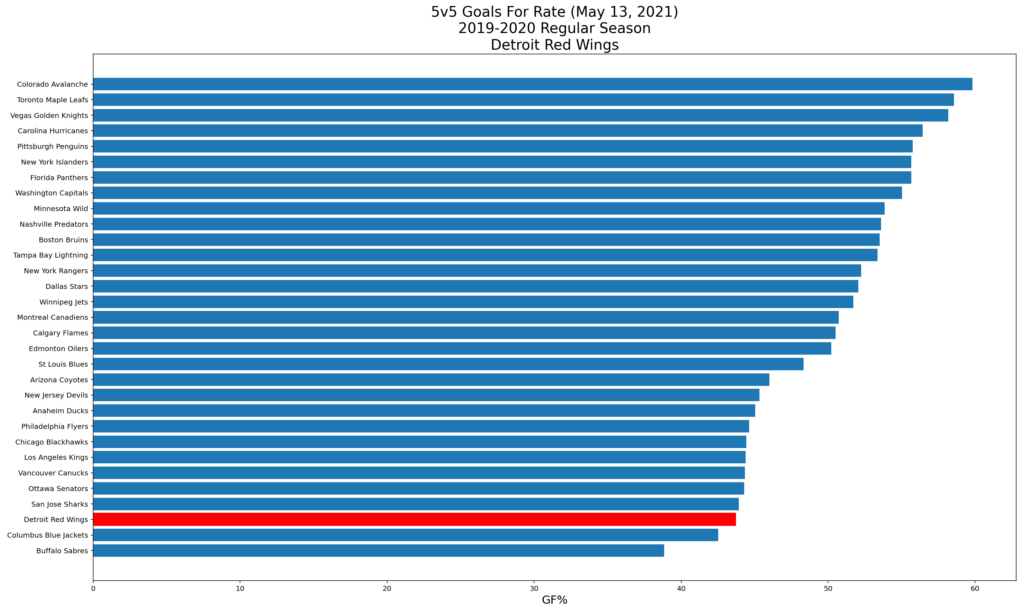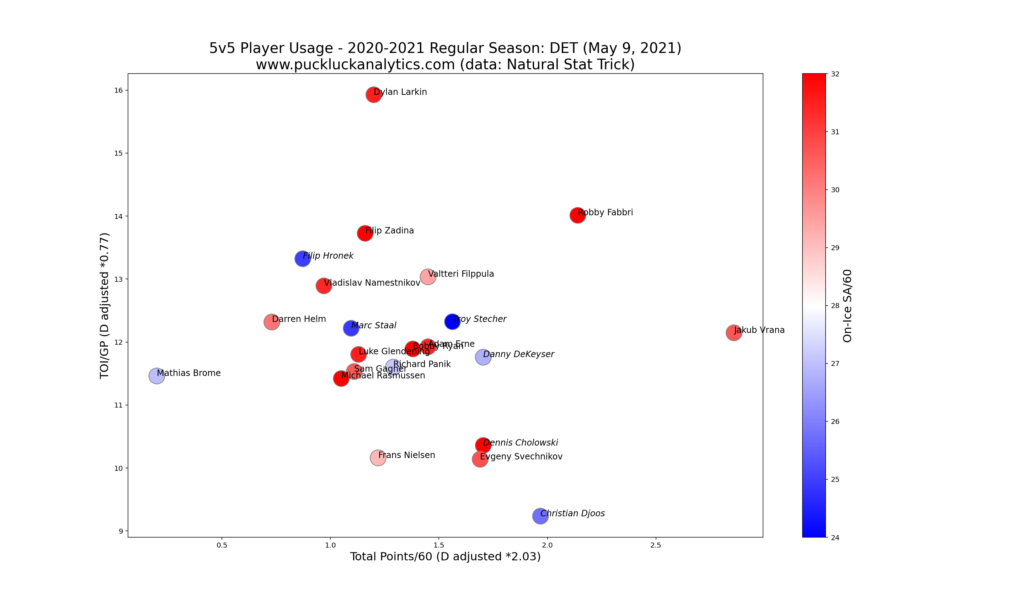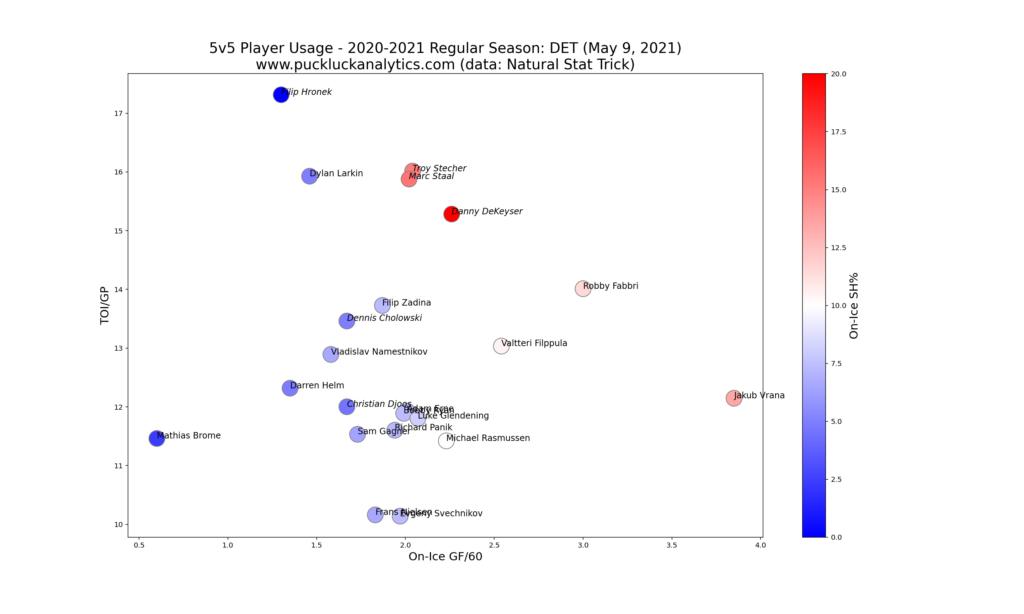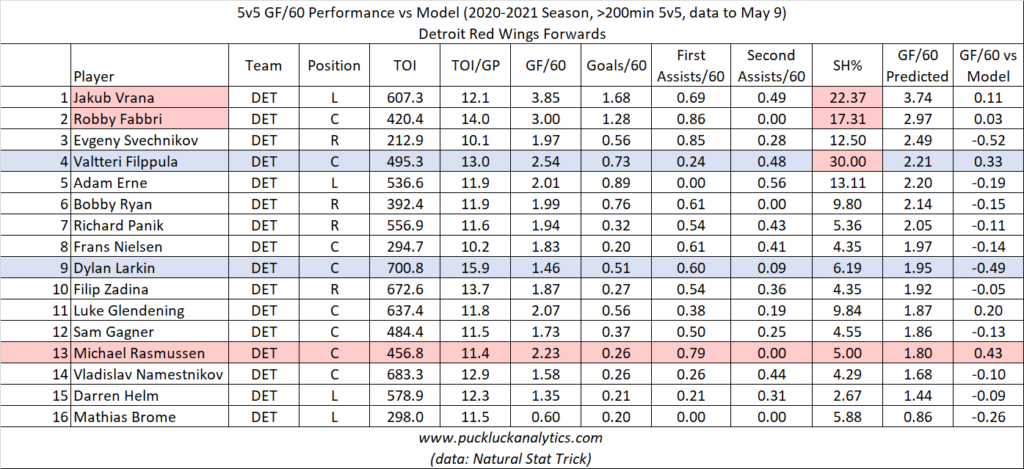We visit the Detroit Red Wings for the second stop in the Central Division in my 2020-2021 season reviews. For more detail on what I’ll be looking for as we go through the review, check out this post.
The Red Wings are deep in the midst of a rebuild and were not expected to contend for a playoff spot this season. GM Steve Yzerman swung some trade deadline deals to continue building up assets for the rebuild and the Wings finished the season 7th in the Central Division.
Overall Performance
As always, we’ll start by looking at the Wings’ regular season results and compare them to our points predictor model output. Since the model uses 5v5 goal rates as inputs, we’ll get a sense of how strongly the Wings results were tied to their 5v5 play this year.
While the Red Wings finished ahead of Columbus in the standings, it was actually a dead heat with the Wings getting the higher spot based on tie-breakers. Our points predictor model agrees, with the Red Wings sitting well back of the playoff teams in the Central based on their 5v5 play as well. With the model output matching the Red Wings actual point percentage quite closely, we expect that this years results will translate into next season (barring any offseason changes and player development) since the Wings results were tied closely with their play at 5 on 5. We expect 5v5 results to be less volatile from season to season than other factors, such as OT results.
Looking at the inputs to the points predictor model, we see where the Red Wings biggest challenge was.
The Wings 5v5 defense was actually in the middle of the pack, sitting 19th in the NHL. However, their 5v5 offense was abysmal, ahead of only Columbus and Buffalo. Combined, this lead to a 30th place GF% at 5v5. While they have room to improve defensively, the Wings clearly need to up their offensive game to begin pushing for a playoff berth.
Player Performance
We’ll dive into player performance by looking at a usage chart with defensemen points and time on ice adjusted for direct comparison with the forwards. Ideally, we’ll see a depth chart on the diagonal from top right to bottom left.
We see more of a scatter than a diagonal line on the plot, indicating that the Wings player utilization was suspect this season. Given the low offensive totals and lack of players standing out offensively, this may simply be a case of the coaching staff generally trying to roll four lines. Jabok Vrana, acquired from the Capitals at the deadline, stands out with offensive production significantly higher than the rest of the team. He will most certainly be given an opportunity to play a large role with the Red Wings next season which may be the first step in improving the Red Wings sputtering offense.
Looking at on-ice GF/60 vs TOI/GP will give us an indication of each players relative impact on team GF/60. Players further to the top right and right had larger team impacts. Forwards and defensemen should not be compared directly.
Again, we see Jacob Vrana to the far right on the plot, seemingly begging for more ice time. Since his numbers here include his time with the Caps prior to the deadline and his role there was limited, this isn’t a surprise. The Wings will expect him to be an impact player next season.
A player we see with offensive impact less than the Wings would like to see is Dylan Larkin. For the nearly 16 minutes of 5v5 TOI/GP he saw this season, the Red Wings could certainly use more offensive production from him.
Similar to the last plot, on-ice SA/60 vs TOI/GP gives us a visual indication of each players relative impact on team GA/60. This time, the best impacts will be closer to left and bottom.
Richard Panik and Mathias Brome stand out here with low on-ice SA/60. With only modest offensive contributions from these players, they look like good options for forward depth.
Moving on to our GF/60 models, we’ll look at how each player performed relative to our model. Generally, players who underperformed the model may be players that can have increased impact next season. We’ll also look for very high or low shooting percentages that can throw off the model prediction and cause discrepancies.
The players with the top 2 predicted GF/60, Vrana and Robbi Fabbri, both benefitted from very high shooting percentages this season. These are likely to regress next season and, with the model results reasonably close to their actual numbers, suggest both players may see some regression in their 5v5 offensive numbers. Still, their offensive production is expected to be quite strong and the Wings should consider these two players as key offensive contributors.
Michael Rasmussen is another player who the Red Wings should be cautious about expectations for next season. He significantly outperformed the GF/60 model, which suggests he relied on line mates for offense. It may be best to reduce his role somewhat to make him more effective.
Conversely, Valtteri Filppula and Larkin both underperformed the model significantly. This suggests they carried their linemates offensively. Given these are two of the more established NHL players on the Wings roster, this shouldn’t be too surprising given their leadership roles on a young team. If the Wings can improve the quality of their line mates, these two players will likely provide improved offensive impact.
It’s interesting to see that all 6 of the Red Wings defenders with over 200 min at 5v5 underperformed the GF/60 model, Djoos, Cholowski, and Hronek by a significant margin, although Cholowski’s shooting percentage was very high for a defenseman. The consistenly negative GF/60 vs Model numbers here suggests that the Red Wings forward group needs some improvement. Poor production from the forwards was likely was a drag on offensive production from the defensemen.
Goaltending impact accounts for roughly half of a team’s 5v5 on-ice GA/60. Here, we see the reason for the Red Wings relatively strong GA/60 among the basement dwelling teams. Thomas Griess and Jonathan Bernier split the starting duties relatively evenly and both goalies had strong numbers this season.
Looking Ahead:
With only $32.5M committed cap hit for next season, the Red Wings have all kinds of flexibility heading into the offseason. Let’s take a look at some key players.
Key RFAs:
Jakub Vrana came to Detroit at the deadline and the 25 year old will be expected to play a large role for the Wings next season. All signs from our review suggest he is primed to excel.
Tyler Bertuzzi played only 9 games this season due to injury. With 48 points in 71 games in 2019-2020, getting a healthy Bertuzzi back in the lineup is sure to help the Wings anemic offense.
Christian Djoos (26), Dennis Cholowski (23) and Filip Hronek (23) all showed promising results from our GF/60 model and will all be restricted free agents this summer. This group of young defensemen look like they can become part of a quality defense corps.
Key UFAs:
Darren Helm (34), Filppula (37), and Luke Glendening (32) will all be unrestricted free agents this offseason. With the Wings in rebuild mode, it wouldn’t be surprising to see all of them land elsewhere next season. If the Wings look to bring one of them back as a veteran presence, Filppula looks like the best choice since he had the best offensive and defensive impacts of the group.
Marc Staal’s $5.7M cap hit also comes off the Red Wings books this summer. He certainly didn’t provide an impact that lived up to that contract and, at age 34, is likely to see declining production on the tail end of his career. He may not be a part of the Red Wings rebuild plan much longer.
Jonathan Bernier heads to the open market this offseason as well. With Greiss locked up for one more season, the Red Wings may not bring 32 year old Bernier back. However, he did provide a very solid 1B option this season. If the price is right, we may see him in a Wings sweater again next year.
Key Players Under Contract:
Captain Dylan Larkin has two years remaining on his deal with a $6.1M cap hit. While his offensive contribution was less than desired at 5 on 5 this season, we saw some signs from our model results that he carried his line mates offensively. If the Red Wings can improve the quality of his line mates in the offseason, they may get more production from Larkin next season.
Defensemen Danny DeKeyser and Troy Stetcher remain under contract with the Wings next season. They both had relatively strong offensive impacts while holding their own defensively. Along with the three young RFA defensemen we discussed, the Wings defense looks like it will be stable heading into next season.
Tough Questions:
When does Steve Yzerman think the Red Wings window to win is? After trading Anthony Mantha (26) for Vrana (25), should the Wings look to continue to get younger? If they do, they have a number of players who are nearing the end of their prime that could be valuable trade chips. With some of their younger players showing the most promise in our review, building a team around Larkin (24), Filip Zadina (21), Vrana (25), Cholowski (23), and Hronek (23) looks like a solid strategy to get the Red Wings back to the playoffs.
Offseason Priority:
The Red Wings should look to be active in the trade market this summer, looking to move players in their prime for younger players that can contribute. In particular, the Red Wings should target young forwards who are ready for top six roles to improve their offense.
Check my previous review from the Central Division on the Columbus Blue Jackets and be sure to subscribe to catch the rest of my season reviews as they come out. Next up is the New Jersey Devils.
data: Natural Stat Trick
cap Data: CapFriendly
